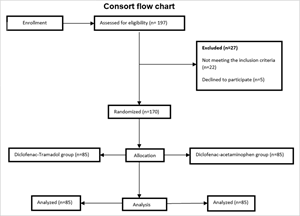Diclofenac-Tramadol Versus Diclofenac-Acetaminophen Combination for Post Caesarean Section Pain Control: A Randomized Controlled Trial
Main Article Content
Abstract
Background: Post-Caesarean section morbidity due to pain is a health concern to both the mother and the clinician. This is because good post-operative pain control helps early recovery and mother-baby bonding with early discharge. Various combinations aimed at this have not had any consensus unlike labour analgesia. This study is aimed at helping clinicians in decision making toward post cesarean pain analgesia. Methodology: This was a double-blinded randomized controlled trial following Caesarean section under spinal anesthesia over a 6month period. One hundred and seventy eligible participants were randomized into two groups. Group A received intramuscular Tramadol 100mg 8 hourly for 24 hours. Group B received intramuscular acetaminophen 600mg 8 hourly for 24 hours. Both groups received Rectal Diclofenac 100mg 8 hourly for 24 hours. The first dose of the drugs was administered one hour after the surgery. All the participants received 10mg of prophylactic metoclopramide. The outcome measures were post-caesarean pain score, participants’ satisfaction and maternal side effects within the first 24 hours. The pain control was assessed using visual analogue scale while patients’ satisfaction was assessed with Likert scale. Analysis: Absolute and relative frequencies of categorical variables, mean, range and standard deviation of continuous variables were calculated. Associations between continuous variables were analyzed using students t-test while chi-square (χ2) test (or Fisher’s exact test where applicable) was used for categorical variables. A P-value of <0.05 was considered significant. Results: The overall pain score was statistically significantly in the diclofenac-tramadol group (P-value <0.001). The Acetaminophen group required more rescue analgesia (63.5% Vs 34.1%) and this was statistically significant (P-value <0.001). The level of association between the types of caesarean section and pain scores both at rest and with movement was statistically significant, with Tramadol group having better pain control. The composite scores in both groups, both at rest, with movement and the types of caesarean section were not statistically significant. On patients satisfaction, 67.1% of the diclofenac-tramadol group was very satisfied as against 30.6% in the diclofenac-acetaminophen group and was statistically significant (P-value = 0.001). The side effect profile was not significant between the two groups. However, the commonest side effects were Dizziness and nausea, which were more in the Tramadol group (10.6% Vs 7.1%). Conclusion: The diclofenac–tramadol combination was more effective in pain control with better patients’ satisfaction and minimal side effects.
Article Details

This work is licensed under a Creative Commons Attribution 4.0 International License.
